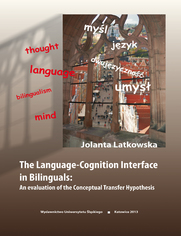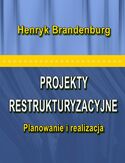The Language-Cognition Interface in Bilinguals: An evaluation of the Conceptual Transfer Hypothesis - Onepress

ISBN: 978-83-801-2205-5
stron: 284, Format: ebook
Data wydania: 2016-08-29
Księgarnia: Onepress
Cena książki: 28,30 zł (poprzednio: 35,38 zł)
Oszczędzasz: 20% (-7,08 zł)
KsiÄ…ĹĽka skierowana jest do studentów i pracowników naukowych filologii obcych, których zainteresowania obejmujÄ… psycholingwistyczne zaleĹĽnoĹ›ci pomiÄ™dzy umysĹ‚owoĹ›ciÄ… a jÄ™zykiem w kontekĹ›cie szeroko pojmowanej dwujÄ™zycznoĹ›ci. Zawiera przeglÄ…d wspóĹ‚czesnych teorii dotyczÄ…cych budowy sĹ‚ownika umysĹ‚owego osób dwujÄ™zycznych, relacji pomiÄ™dzy myĹ›lÄ… a jÄ™zykiem oraz dyskusjÄ™ najnowszych badaĹ„ przeprowadzonych w oĹ›rodkach krajowych i zagranicznych. Punktem odniesienia w analizie powyĹĽszych zagadnieĹ„ jest hipoteza transferu konceptualnego autorstwa znanych amerykaĹ„skich psycholingwistów Anety Pavlenko i Scotta Jarvisa.
NiewÄ…tpliwym atutem ksiÄ…ĹĽki jest jej część badawcza przedstawiajÄ…ca wyniki badaĹ„ nad dwujÄ™zycznoĹ›ciÄ… studentów filologii angielskiej w Polsce oraz polskich emigrantów w Wielkiej Brytanii i Irlandii, które przeprowadzono w latach 2008-2010. Zebrane dane sÄ… podstawÄ… oceny zasadnoĹ›ci zaĹ‚oĹĽeĹ„ omawianej w pracy hipotezy. Ponadto, pozwalajÄ… na porównanie efektywnoĹ›ci uczenia siÄ™ jÄ™zyka drugiego (obcego) w warunkach szkolnych i naturalnych oraz obrazujÄ… jak intensywny kontakt z dwoma jÄ™zykami ksztaĹ‚tuje rozumienie i uĹĽycie znaczeĹ„ semantycznych i konstrukcjÄ™ narracji w obu jÄ™zykach.
Osoby które kupowały "The Language-Cognition Interface in Bilinguals: An evaluation of the Conceptual Transfer Hypothesis", wybierały także:
- English 4 IT. Praktyczny kurs j 49,67 zł, (14,90 zł -70%)
- Ucz si 9,67 zł, (2,90 zł -70%)
- Zyskaj angielski akcent. Kurs video. Trening wymowy 99,00 zł, (39,60 zł -60%)
- English 4 IT. Praktyczny kurs j 59,00 zł, (26,55 zł -55%)
- ASAP. Jak nauczyć się języka obcego tak szybko, jak to możliwe 34,15 zł, (15,71 zł -54%)
Spis treści
The Language-Cognition Interface in Bilinguals: An evaluation of the Conceptual Transfer Hypothesis eBook -- spis treści
Table of сontents
Acknowledgements / 9
Introduction / 11
1. The architecture of the bilingual mental lexicon / 15
1.1. The Hierarchical Model of Bilingual Memory / 15
1.1.1. Unity of the semantic and conceptual levels / 17
1.1.2. Separation of semantic and conceptual representations / 19
1.2. The concept of concept / 21
1.2.1. Feature listings / 22
1.2.2. Prototypes / 23
1.2.3. Frames / 26
1.2.4. Conceptual metaphor and image schemas / 27
1.2.5. Grounded cognition / 30
1.3. Lexical(ized) concepts / 31
1.4. Analysing lexicalized concepts: Natural Semantic Metalanguage / 36
1.4.1. Semantic explications / 39
1.4.2. Semantic molecules / 40
1.4.3. Neo-Whorfianism, Wierzbicka style / 41
1.5. Language-mediated processes in the bilingual lexicon / 42
1.5.1. Lexical and semantic transfer / 42
1.5.2. Conceptual transfer / 45
1.5.2.1. Linguistic relativity / 45
1.5.2.2. The Conceptual Transfer Hypothesis / 47
1.6. Conclusion / 47
2. Linguistic relativity / 49
2.1. The Sapir-Whorf Hypothesis: Perspectives from research design / 49
2.1.1. The domain-specific approach / 50
2.1.2. The structure-centred approach / 55
2.1.3. The bilingual perspective / 57
2.2. The Thinking for Speaking Hypothesis / 62
2.2.1. Background to the Thinking for Speaking Hypothesis: Talmy’s typology of motion verbs / 63
2.2.2. Critique of Talmy / 65
2.2.3. Directed motion in Polish / 67
2.2.4. The Whorfian dimension of Thinking for Speaking / 71
2.2.5. Thinking for Speaking effects in gestural communication / 74
2.2.6. Bilingual research / 75
2.3. Conceptualization via event construal: The von Stutterheim paradigm / 79
2.3.1. Processes of conceptualization / 80
2.3.2. Evidence from Slavic languages / 85
2.3.3. Conceptualization in bilinguals and second/foreign language learners / 87
2.4. Linguistic relativity: General perspective / 90
2.5. Conclusion / 98
3. The Conceptual Transfer Hypothesis / 100
3.1. Assessing the scope of the phenomenon / 101
3.2. Issues in investigating the linguistic/non-linguistic interface / 102
3.3. Methodological concerns / 105
3.4. The linguistic dimension / 110
3.5. Conclusion / 114
4. Study 1: Investigating semantic and conceptual categorization in the domain of interpersonal relationships in Polish and English / 115
4.1. Naming interpersonal relationships in Polish and English / 117
4.2. Study 1a / 121
4.2.1. Research questions / 122
4.2.2. Participants / 122
4.2.3. Materials / 124
4.2.4. Procedure / 130
4.2.5. Analysis / 131
4.2.6. Results / 132
4.2.6.1. Intra-group variables / 154
4.2.6.2. Category core features / 158
4.2.7. Discussion and summary of findings / 160
4.2.7.1. Bilingual categorization patterns in the L2 / 160
4.2.7.2. Bilingual categorization patterns in the L1 / 162
4.2.7.3. The processes at work in the bilingual lexicon / 163
4.2.7.4. The L2 and L1 in natural and formal learning contexts / 165
4.2.7.5. Factors influencing naming patterns in bilinguals / 167
4.2.7.6. On the application of Natural Semantic Metalanguage and linguistic analyses in research into semantic and conceptual levels / 169
4.3. Study 1b / 172
4.3.1. Research objectives / 172
4.3.2. Participants / 173
4.3.3. Materials / 173
4.3.4. Procedure / 174
4.3.5. Analysis / 175
4.3.6. Results and discussion / 175
4.3.7. Conclusion / 180
5. Study 2: Conceptualization in event construal. The case of Polish‑English bilinguals / 181
5.1. Study 2a / 183
5.1.1. Selection / 183
5.1.2. Research objectives / 184
5.1.3. Participants / 185
5.1.4. Materials / 186
5.1.5. Procedure / 187
5.1.6. Analysis / 187
5.1.7. Results / 189
5.1.8. Discussion / 200
5.1.8.1. Selection: A cross-linguistic analysis / 201
5.1.8.2. The setting of L2 learning and use / 202
5.1.8.3. The influence of individual background variables / 203
5.1.8.4. Implications for conceptualization processes / 204
5.1.9. Conclusion / 204
5.2. Study 2b / 205
5.2.1. Segmentation / 205
5.2.2. Structuring / 206
5.2.3. Research objectives / 208
5.2.4. Materials and procedure / 208
5.2.5. Analysis / 209
5.2.5.1. Segmentation units / 209
5.2.5.2. The event/state distinction / 210
5.2.5.3. Temporal structuring / 211
5.2.5.4. Statistical analysis / 212
5.2.6. Results / 212
5.2.7. Discussion / 232
5.2.7.1. Event segmentation: A cross-linguistic perspective / 232
5.2.7.2. Temporal structuring in Polish and English / 233
5.2.7.3. The setting of L2 learning and use / 234
5.2.7.4. The influence of individual background variables / 236
5.2.7.5. Implications for conceptualization processes / 237
5.2.8. Conclusion / 238
6. Concluding remarks / 240
6.1. Theoretical issues and suggestions for future research / 240
6.2. Practical implications of Studies 1 and 2 / 243
6.3. Evaluation of the research / 246
Appendix / 248
Bibliography / 259
Index / 279
Streszczenie / 281
Zusammenfassung / 282





